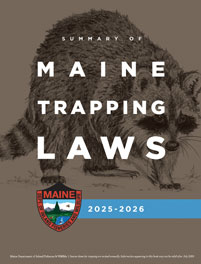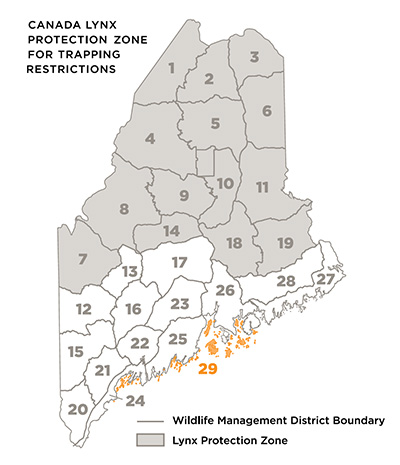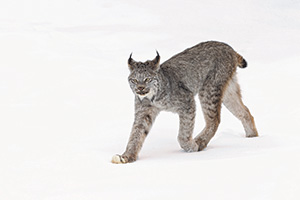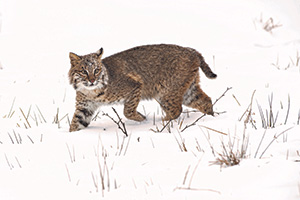Home → Hunting & Trapping → Trapping → Laws & Rules → Lynx Protection Zone and Trap Restrictions
Lynx Protection and Trap Restrictions

On this page:
- Foothold Traps
- Killer-type (Conibear) Traps
- What do I do if I Catch a Lynx?
- Canada Lynx Protection Zone for Trapping Restrictions
- Lynx vs. Bobcat: Know the Difference
Canada lynx are a federally listed Threatened Species. There is no open season for the trapping or hunting of lynx in Maine. The Department has delineated statewide and WMD specific regulations to protect lynx and to help Maine trappers avoid accidentally taking lynx.
Foothold Traps
- Statewide: When set on dry land, trap must have at least three swiveling points (at the base of the trap, midway in the chain, and at the trap's anchoring point). Foothold traps cannot be set above ground or snow level. These restrictions do not apply to foothold traps that when set, placed, or tended are fully or partially covered by water, those that are set on a muskrat "float", or dog-proof traps also known as enclosed foothold traps.
- WMDs 1-11, 14, 18, and 19: When set on dry land, the use of drags is prohibited and the catch circle must be cleared of woody vegetation, debris and man-made material that could cause entanglement of a trapped animal.
- WMDs 1-6 and 8-11: No foothold trap may be used that has an inside jaw spread of more than 5⅜ inches unless when set, placed, and tended, the trap is completely underwater.
Killer-type (Conibear) Traps
Statewide: Killer-type (conibear) traps must be set within a lynx exclusion device when set on dry land, except that killer-type traps with an inside jaw spread of 5 inches or less may be set without an exclusion device if the trap is set so as to be partially covered by water at all times, set under an overhanging stream bank, or used at a blind set without the use of bait, lure or visible attractor. For more information on foothold and killer-type traps, see Regulations for Specific Types of Traps.
What do I do if I Catch a Lynx?
A person who catches a lynx must call the lynx hotline at (207) 592-4734 or a local game warden as soon as possible and prior to removing the animal from the trap, unless a Department official cannot be reached in time to prevent injury to the lynx. Any lynx released under this provision must be reported to the Department within 24 hours from this time it was discovered.
The lynx hotline ((207) 592-4734) is staffed 24 hours a day, 7 days a week during the trapping season. In most circumstances a biologist will chemically immobilize, examine, and release the lynx. For more information on lynx please call (207) 287-8000 or visit the lynx page.
If you catch a cat and are uncertain whether it is a bobcat or a lynx, please contact us immediately at (207) 592-4734.
Canada Lynx Protection Zone for Trapping Restrictions

Lynx vs. Bobcat: Know the Difference
Make sure you take the time to identify your target. Bobcats are similar in appearance to Canada lynx and are a legal furbearer in Maine that can be harvested during the open trapping and hunting season for bobcats. If you trap a bobcat that looks like a cross between a lynx and a bobcat, we would like to know about it. We have recovered several lynx-bobcat hybrids in north central Maine and are interested in documenting other specimens. Remember, if you are uncertain whether you have trapped a lynx or a bobcat, please call a biologist or warden before dispatching the animal. If you have already dispatched the animal, and think it has unusual characteristics for a bobcat, we are still interested in seeing it.

Canada lynx
- Longer ear tufts (1" or longer)
- Longer facial ruff
- Shorter and completely black-tipped tail
- Large and well-furred feet (>3" track)
- Uniform coat color

Bobcat
- Shorter ear tufts (absent to 1")
- Shorter facial ruff – more round face
- Tail black-tipped on top and white underneath
- Smaller feet (2" track)
- Less-uniform coat (white underbelly, spotted)